Related Research Articles

The Communist Party of Indonesia was a communist party in Indonesia. It was the largest non-ruling communist party in the world before its violent disbandment in 1965. The party had two million members in the 1955 elections, with 16 percent of the national vote and almost 30 percent of the vote in East Java. During most of the period immediately following the Indonesian Independence until the eradication of the PKI in 1965, it was a legal party operating openly in the country.
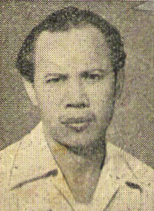
Muhammad Hatta Lukman was an Indonesian communist politician, who served as the First Deputy Chairman of the Central Committee of the Communist Party of Indonesia (PKI), and a member of the People's Representative Council from 1956 until 1959. He was executed following the 1965 crackdown on the PKI.
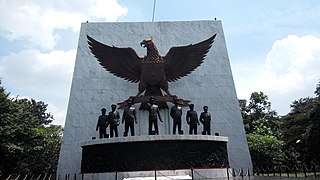
The Thirtieth of September Movement was a self-proclaimed organization of Indonesian National Armed Forces members who, in the early hours of 1 October 1965, assassinated six Indonesian Army generals in an abortive coup d'état, resulting in the unofficial but more accurate name of Gestok, for Gerakan Satu Oktober, or First of October Movement. Later that morning, the organisation declared that it was in control of media and communication outlets and had taken President Sukarno under its protection. By the end of the day, the coup attempt had failed in Jakarta. Meanwhile, in central Java there was an attempt to take control over an army division and several cities. By the time this rebellion was put down, two more senior officers were dead.
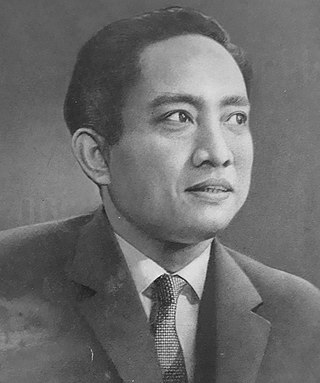
Dipa Nusantara Aidit was an Indonesian communist politician, who served as General Secretary of the Communist Party of Indonesia (PKI) from 1951 until his summary execution during the mass killings of 1965–66. Born on Belitung Island, he was nicknamed "Amat". Aidit was educated in the Dutch colonial system.

Munawar Musso was a leader of the Communist Party of Indonesia and one of the key figures in the 1948 Madiun affair.

Guided Democracy was the political system in place in Indonesia from 1959 until the New Order began in 1966. It was the brainchild of President Sukarno, and was an attempt to bring about political stability. Sukarno believed that the parliamentarian system implemented during the liberal democracy period in Indonesia was ineffective due to its divisive political situation at that time. Instead, he sought a system based on the traditional village system of discussion and consensus, which occurred under the guidance of village elders. With the declaration of martial law and the introduction of this system, Indonesia returned to the presidential system and Sukarno became the head of government again.
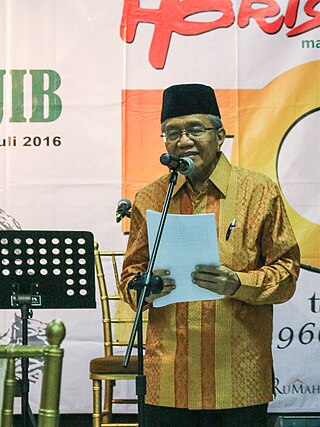
Taufiq Ismail is an Indonesian poet, activist and the editor of the monthly literary magazine Horison. Ismail figured prominently in Indonesian literature of the post-Sukarno period and is considered one of the pioneers of the "Generation of '66". He completed his education at the University of Indonesia. Before becoming active as a writer, he taught at the Institut Pertanian Bogor. In 1963, he signed the "Cultural Manifesto" as a document that opposed linking art to politics. This cost him his teaching position at the Institut.

Pikiran Rakyat is a daily newspaper published in Bandung, West Java, Indonesia. Its circulation covers West Java and Banten Province.
Lukman Njoto or Njoto was a senior national leader of the Communist Party of Indonesia (PKI), who joined the party shortly after the country's declaration of independence, and was killed following the 1965 coup attempt.
The Lembaga Kebudajaan Rakjat was a prolific cultural and social movement associated with the Indonesian Communist Party. Founded in 1950, Lekra pushed for artists, writers and teachers to follow the doctrine of socialist realism. Increasingly vocal against non-Lekra members, the group rallied against the Manifes Kebudayaan, eventually leading to President Sukarno banning it with some hesitations. After the 30 September Movement, Lekra was banned together with the communist party.

S. Rukiah was an Indonesian poet and novelist.
Indonesian exile literature refers to works of Indonesian literature produced by writers living in exile after the 30 September Movement led an abortive coup d'état in 1965. This applies especially those living in Western Europe, with a focus on the Netherlands. Exile literature is not a literary school, but rather a literary incarnation of a unique political situation.
Indonesia following independence from the Netherlands in the 1940s to the Indonesian killings of 1965–66 was subjected to extensive cultural change, and a range of possible political directions suring the Sukarno era.
The Cultural Manifesto was a declaration by a group of Indonesian writers and intellectuals in late 1963. The Cultural Manifesto was initiated by HB Jassin, Trisno Sumardjo, Wiratmo Soekito, Zaini, Bokor Hutasuhut, Gunawan Mohamad, A. Bastari Asnin, Bur Rasuanto, Soe Hok Djin, DS Moeljanto, Ras Siregar, Hartojo Andangdjaja, Sjahwil, Djufri Tanissan, Binsar Sitompul, Gerson Poyk, Taufiq Ismail, M. Saribi, Poernawan Tjondronegoro, Ekana Siswojo, Nashar and Boen S. Oemarjati. The group that constituted the Cultural Manifesto was in ideological contrast to Lekra. Members of the Lekra movement nicknamed the Cultural Manifesto "Manikebu," a humorous abbreviation that in English means "Buffalo Sperm."

Wikana was an Indonesian minister and independence leader. He was one of the youths who forced Sukarno and Hatta to declare independence immediately after the surrender of the Japanese. He was the first Indonesian Minister of Youth and Sport. He was a member of the Indonesian Communist Party. Sometime after the 1965 coup d'état attempt, he was arrested and went missing, it is supposed that he was one of the assassinated in the Indonesian mass killings of 1965–66.

Bintang Merah was a magazine of the Communist Party of Indonesia which published in Jakarta from 1945 to 1948 and again from 1950 to 1965. It described itself as a magazine of Marxist-Leninist politics and theory.
Asmu, whose birth name was Asmoe Tjiptodarsono, was a leader, theoretician, and chief agricultural expert of the Indonesian Communist Party (PKI) and head of the Communist-affiliated Peasants Front of Indonesia in the mid-1960s. He was killed during the Indonesian mass killings of 1965–66.
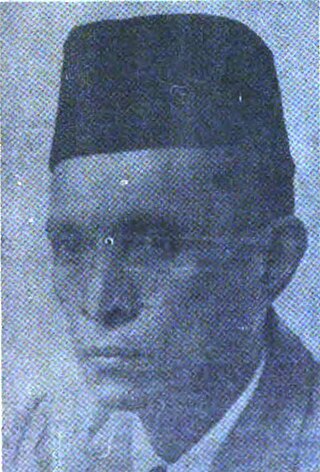
Abdullah Aidit was an Indonesian politician and civil servant who served as a member of the Provisional People's Representative Council. He was the father of D. N. Aidit, chairman of the Indonesian Communist Party who was executed in 1965 following the 30 September Movement.

Sri Koesnapsijah was a Javanese language writer and activist of the Dutch East Indies and Indonesia who was among the generation of Indonesian women writers active in the 1930s. She was known for her short stories and articles which she published in the magazine Panjebar Semangat in the 1930s and 1940s, where she was also an assistant editor. After Indonesian independence she was active in the Communist Party-affiliated Gerwani movement, and was briefly a representative of the Communist Party in the Jakarta-area consultative body DPR-GR. She was arrested in late 1965 during the anti-communist repression of the Transition to the New Order and imprisoned without charge for the following decade.

Colonel Dahlan Djambek was a military officer, independence fighter, and minister in the Cabinet of the Revolutionary Government of the Republic of Indonesia (PRRI). During the Japanese occupation of West Sumatra, he was appointed Chairman of the Sumatra Chokai.
References
- Taufik Rahzen, dkk (2007). Seabad Pers Kebangsaan (1907–2007). Yogyakarta: I:Boekoe.
- Rhoma Dwi Aria dan Muhidin M. Dahlan (2008). Lekra Tak Membakar Buku. Yogyakarta: Merekasumba.
- Arif Zulkifi, dkk (2014). Seri Buku Tempo: Lekra dan Geger 1965. Jakarta: Kepustakaan Populer Gramedia.